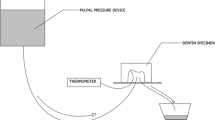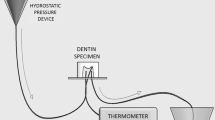Abstract
The study evaluated the pulp temperature (PT) increase in Class I and V preparations when exposed to the Monet Laser (for 1 and 3 s), the PinkWave (for 3 and 10 s), the Valo Grand (for 3 and 10 s), the PowerCure, (for 3 and 10 s) and the SmartLite Pro (for 10 s). Non-retentive Class I and Class V cavities were prepared in one molar fixed in an acrylic plate and positioned in a warm water bath. The PT baseline was kept at 32 °C to simulate physiological conditions. Two T-type thermocouples were inserted through the roots into the pulp chamber in two positions: close to the pulp horn and the buccal wall close to the Class V cavity. The water flow was adjusted to 0.026 mL/min, and real-time temperature data were collected every 0.5 s. PT measurements were made with the tip of the LCU 0 and 6 mm away from the tooth surface. The radiant exitance (mW/cm2) and radiant exposure (J/cm2) were calculated. One-way ANOVA compared the effect of the pulpal flow, and ΔT values were subjected to two-way ANOVA, followed by Scheffe’s post hoc tests. The Monet Laser used for 3 s and the PinkWave used for 10 s produced the greatest PT rise in the Class I cavity. The simulated pulpal flow did not influence the PT rise. Overall, cavities exposed at the 0 mm distance had higher ΔT values than groups at 6 mm distance. The placement of a rubber dam for Class V restorations may prevent positioning LCUs directly over the cavity, which may affect the rise in PT.






Similar content being viewed by others
Data availability
The data that support the findings of this study are available from the corresponding author, CAG Arrais, upon reasonable request.
References
Jandt KD, Mills RW. A brief history of LED photopolymerization. Dent Mater. 2013;29(6):605–17. https://doi.org/10.1016/j.dental.2013.02.003.
Milly H, Banerjee A. Evaluating the clinical use of light-emitting diode vs halogen photocuring units. Oral Health Prev Dent. 2018;16(1):21–5. https://doi.org/10.3290/j.ohpd.a39822.
Rueggeberg FA, Giannini M, Arrais CAG, Price RBT. Light curing in dentistry and clinical implications: a literature review. Braz Oral Res. 2017;31(suppl 1): e61. https://doi.org/10.1590/1807-3107BOR-2017.vol31.0061.
Apex V. Pinkwave. https://vistaapex.com/wp-content/uploads/2021/03/91037-I-AP-ENG5.pdf. Accessed 22 Feb 2022
Knezevic A, Ristic M, Demoli N, Tarle Z, Music S, Negovetic MV. Composite photopolymerization with diode laser. Oper Dent. 2007;32(3):279–84. https://doi.org/10.2341/06-79.
Drost T, Reimann S, Frentzen M, Meister J. Effectiveness of photopolymerization in composite resins using a novel 445-nm diode laser in comparison to LED and halogen bulb technology. Lasers Med Sci. 2019;34(4):729–36. https://doi.org/10.1007/s10103-018-2651-1.
Kouros P, Dionysopoulos D, Deligianni A, Strakas D, Sfeikos T, Tolidis K. Evaluation of photopolymerization efficacy and temperature rise of a composite resin using a blue diode laser (445 nm). Eur J Oral Sci. 2020;128(6):535–41. https://doi.org/10.1111/eos.12742.
AMD. Monet Laser Curing Light. The 1 second revolution. 2021. https://www.amdlasers.com/pages/monet-laser-curing-light-intro. Accessed 12 Oct 2021.
Rocha MG, Maucoski C, Roulet JF, Price RB. Depth of cure of 10 resin-based composites light-activated using a laser diode, multi-peak, and single-peak light-emitting diode curing lights. J Dent. 2022. https://doi.org/10.1016/j.jdent.2022.104141.
Almeida R, Manarte-Monteiro P, Domingues J, Falcao C, Herrero-Climent M, Rios-Carrasco B, et al. High-power LED units currently available for dental resin-based materials—a review. Polymers (Basel). 2021. https://doi.org/10.3390/polym13132165.
Mouhat M, Mercer J, Stangvaltaite L, Ortengren U. Light-Curing Units used in dentistry: factors associated with heat development-potential risk for patients. Clin Oral Investig. 2017;21(5):1687–96. https://doi.org/10.1007/s00784-016-1962-5.
Armellin E, Bovesecchi G, Coppa P, Pasquantonio G, Cerroni L. LED curing lights and temperature changes in different tooth sites. Biomed Res Int. 2016;2016:1894672. https://doi.org/10.1155/2016/1894672.
Price RB, Ferracane JL, Shortall AC. Light-Curing Units: a review of what we need to know. J Dent Res. 2015;94(9):1179–86. https://doi.org/10.1177/0022034515594786.
Par M, Repusic I, Skenderovic H, Milat O, Spajic J, Tarle Z. The effects of extended curing time and radiant energy on microhardness and temperature rise of conventional and bulk-fill resin composites. Clin Oral Investig. 2019;23(10):3777–88. https://doi.org/10.1007/s00784-019-02807-1.
Wang WJ, Grymak A, Waddell JN, Choi JJE. The effect of light curing intensity on bulk-fill composite resins: heat generation and chemomechanical properties. Biomater Investig Dent. 2021;8(1):137–51. https://doi.org/10.1080/26415275.2021.1979981.
Balestrino A, Verissimo C, Tantbirojn D, Garcia-Godoy F, Soares CJ, Versluis A. Heat generated during light-curing of restorative composites: effect of curing light, exotherm, and experiment substrate. Am J Dent. 2016;29(4):234–2240.
Akarsu S, Aktug KS. Influence of bulk-fill composites, polimerization modes, and remaining dentin thickness on intrapulpal temperature rise. Biomed Res Int. 2019;2019:4250284. https://doi.org/10.1155/2019/4250284.
Mouhat M, Stangvaltaite-Mouhat L, Mercer J, Nilsen BW, Ortengren U. Light-curing units used in dentistry: effect of their characteristics on temperature development in teeth. Dent Mater J. 2021. https://doi.org/10.4012/dmj.2020-305.
Savas S, Botsali MS, Kucukyilmaz E, Sari T. Evaluation of temperature changes in the pulp chamber during polymerization of light-cured pulp-capping materials by using a VALO LED Light Curing Unit at different curing distances. Dent Mater J. 2014;33(6):764–9. https://doi.org/10.4012/dmj.2013-274.
Braga S, Oliveira L, Ribeiro M, Vilela A, da Silva GR, Price RB, et al. Effect of simulated pulpal microcirculation on temperature when light curing bulk fill composites. Oper Dent. 2019;44(3):289–301. https://doi.org/10.2341/17-351-L.
Price RB, Ferracane JL, Hickel R, Sullivan B. The Light-Curing Unit: an essential piece of dental equipment. Int Dent J. 2020;70(6):407–17. https://doi.org/10.1111/idj.12582.
Price RB, Derand T, Sedarous M, Andreou P, Loney RW. Effect of distance on the power density from two light guides. J Esthet Dent. 2000;12(6):320–7. https://doi.org/10.1111/j.1708-8240.2000.tb00241.x.
Oberholzer TG, Makofane ME, du Preez IC, George R. Modern high powered led curing lights and their effect on pulp chamber temperature of bulk and incrementally cured composite resin. Eur J Prosthodont Restor Dent. 2012;20(2):50–5.
Zach L, Cohen G. Pulp response to externally applied heat. Oral Surg Oral Med Oral Pathol. 1965;19(4):515–30. https://doi.org/10.1016/0030-4220(65)90015-0.
Maucoski C, Zarpellon DC, Dos Santos FA, Lipinski LC, Campagnoli EB, Rueggeberg FA, et al. Analysis of temperature increase in swine gingiva after exposure to a polywave((R)) LED Light Curing Unit. Dent Mater. 2017;33(11):1266–73. https://doi.org/10.1016/j.dental.2017.07.021.
Spranley TJ, Winkler M, Dagate J, Oncale D, Strother E. Curing light burns. Gen Dent. 2012;60(4):e210–4.
Vinall CV, Garcia-Silva TC, Lou JSB, Wells MH, Tantbirojn D, Versluis A. Intrapulpal temperature rise during light activation of restorative composites in a primary molar. Pediatr Dent. 2017;39(3):125–30.
Lee C-H, Lee I-B. Effects of wall compliance and light-curing protocol on wall deflection of simulated cavities in bulk-fill composite restoration. J Dent Sci. 2021. https://doi.org/10.1016/j.jds.2021.03.017.
Lempel E, Ori Z, Kincses D, Lovasz BV, Kunsagi-Mate S, Szalma J. Degree of conversion and in vitro temperature rise of pulp chamber during polymerization of flowable and sculptable conventional, bulk-fill and short-fibre reinforced resin composites. Dent Mater. 2021;37(6):983–97. https://doi.org/10.1016/j.dental.2021.02.013.
Gross DJ, Davila-Sanchez A, Runnacles P, Zarpellon DC, Kiratcz F, Campagnoli EB, et al. In vivo temperature rise and acute inflammatory response in anesthetized human pulp tissue of premolars having Class V preparations after exposure to Polywave(R) LED Light Curing Units. Dent Mater. 2020;36(9):1201–13. https://doi.org/10.1016/j.dental.2020.05.015.
Zarpellon DC, Runnacles P, Maucoski C, Gross DJ, Coelho U, Rueggeberg FA, et al. In vivo pulp temperature changes during class V cavity preparation and resin composite restoration in premolars. Oper Dent. 2021. https://doi.org/10.2341/20-098-C.
Zarpellon DC, Runnacles P, Maucoski C, Coelho U, Rueggeberg FA, Arrais C. Controlling in vivo, human pulp temperature rise caused by LED curing light exposure. Oper Dent. 2019;44(3):235–41. https://doi.org/10.2341/17-364-C.
Runnacles P, Arrais CAG, Maucoski C, Coelho U, De Goes MF, Rueggeberg FA. Comparison of in vivo and in vitro models to evaluate pulp temperature rise during exposure to a polywave(R) LED Light Curing Unit. J Appl Oral Sci. 2019;27: e20180480. https://doi.org/10.1590/1678-7757-2018-0480.
Berggreen E, Bletsa A, Heyeraas KJ. Circulation in normal and inflamed dental pulp. Endod Top. 2007;17(1):2–11. https://doi.org/10.1111/j.1601-1546.2010.00249.x.
Sukapattee M, Wanachantararak S, Sirimaharaj V, Vongsavan N, Matthews B. Effect of full crown preparation on pulpal blood flow in man. Arch Oral Biol. 2016;70:111–6. https://doi.org/10.1016/j.archoralbio.2016.06.005.
Odor TM, Pitt Ford TR, McDonald F. Adrenaline in local anaesthesia: the effect of concentration on dental pulpal circulation and anaesthesia. Endod Dent Traumatol. 1994;10(4):167–73. https://doi.org/10.1111/j.1600-9657.1994.tb00681.x.
Vongsavan K, Samdrup T, Kijsamanmith K, Rirattanapong P, Vongsavan N. The effect of intraosseous local anesthesia of 4% articaine with 1:100,000 epinephrine on pulpal blood flow and pulpal anesthesia of mandibular molars and canines. Clin Oral Investig. 2019;23(2):673–80. https://doi.org/10.1007/s00784-018-2481-3.
Zheng QH, Hong QC, Zhang L, Ye L, Huang DM. A clinical study on the effect of injection sites on efficacy of anesthesia and pulpal blood flow in carious teeth. Oper Dent. 2018;43(1):22–30. https://doi.org/10.2341/16-371-C.
Rueggeberg F. Contemporary issues in photocuring. Compend Contin Educ Dent Suppl. 1999;25:S4-15 (quiz S73).
Lin M, Xu F, Lu TJ, Bai BF. A review of heat transfer in human tooth—experimental characterization and mathematical modeling. Dent Mater. 2010;26(6):501–13. https://doi.org/10.1016/j.dental.2010.02.009.
Pires JA, Cvitko E, Denehy GE, Swift EJ Jr. Effects of curing tip distance on light intensity and composite resin microhardness. Quintessence Int. 1993;24(7):517–21.
Runnacles P, Arrais CA, Pochapski MT, Dos Santos FA, Coelho U, Gomes JC, et al. In vivo temperature rise in anesthetized human pulp during exposure to a polywave LED Light Curing Unit. Dent Mater. 2015;31(5):505–13. https://doi.org/10.1016/j.dental.2015.02.001.
Vatansever F, Hamblin MR. Far infrared radiation (FIR): its biological effects and medical applications. Photonics Lasers Med. 2012;4:255–66. https://doi.org/10.1515/plm-2012-0034.
Molnár E, Lohinai Z, Demeter A, Mikecs B, Tóth Z, Vág J. Assessment of heat provocation tests on the human gingiva: the effect of periodontal disease and smoking. Acta Physiol Hung. 2015;102(2):176–88. https://doi.org/10.1556/036.102.2015.2.8.
Kodonas K, Gogos C, Tziafas D. Effect of simulated pulpal microcirculation on intrapulpal temperature changes following application of heat on tooth surfaces. Int Endod J. 2009;42(3):247–52. https://doi.org/10.1111/j.1365-2591.2008.01508.x.
Kodonas K, Gogos C, Tziafa C. Effect of simulated pulpal microcirculation on intrachamber temperature changes following application of various curing units on tooth surface. J Dent. 2009;37(6):485–90. https://doi.org/10.1016/j.jdent.2009.03.006.
Park SH, Roulet JF, Heintze SD. Parameters influencing increase in pulp chamber temperature with light-curing devices: curing lights and pulpal flow rates. Oper Dent. 2010;35(3):353–61. https://doi.org/10.2341/09-234-L.
Yazici AR, Müftü A, Kugel G, Perry RD. Comparison of temperature changes in the pulp chamber induced by various light curing units, in vitro. Oper Dent. 2006;31:261–5. https://doi.org/10.2341/05-26.
Aguiar FH, Barros GK, Lima DA, Ambrosano GM, Lovadino JR. Effect of composite resin polymerization modes on temperature rise in human dentin of different thicknesses: an in vitro study. Biomed Mater. 2006;1(3):140–3. https://doi.org/10.1088/1748-6041/1/3/008.
Murray PE, Smith AJ, Windsor LJ, Mjör IA. Remaining dentine thickness and human pulp responses. Int Endod J. 2003;36:33–43.
Acknowledgements
This study was supported by a Mitacs travel grant (IT29166), a Coordenação de Aperfeiçoamento de Pessoal de Nível Superior-Brazil (CAPES)—Finance Code 001grant, and an internal research fund grant from the Faculty of Dentistry, Dalhousie University.
Author information
Authors and Affiliations
Corresponding author
Ethics declarations
Ethics approval
Approval was obtained from the Health Sciences Research Ethics Board of Dalhousie University, Halifax, NS, Canada (#2021-5703).
Conflict of interests
The authors declare that there is no conflict of interest in this study.
Additional information
Publisher's Note
Springer Nature remains neutral with regard to jurisdictional claims in published maps and institutional affiliations.
Rights and permissions
Springer Nature or its licensor (e.g. a society or other partner) holds exclusive rights to this article under a publishing agreement with the author(s) or other rightsholder(s); author self-archiving of the accepted manuscript version of this article is solely governed by the terms of such publishing agreement and applicable law.
About this article
Cite this article
Maucoski, C., Price, R.B., Arrais, C.A.G. et al. In vitro temperature changes in the pulp chamber caused by laser and Quadwave LED-light curing units. Odontology 111, 668–679 (2023). https://doi.org/10.1007/s10266-022-00780-y
Received:
Accepted:
Published:
Issue Date:
DOI: https://doi.org/10.1007/s10266-022-00780-y




